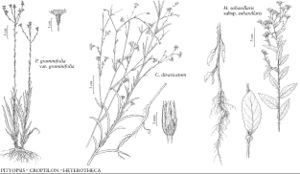Pityopsis
Trans. Amer. Philos. Soc., n. s. 7: 317–318. 1840.
| Taxon | Illustrator ⠉ | |
|---|---|---|
 | Pityopsis graminifolia var. graminifolia Croptilon divaricatum Heterotheca subaxillaris subsp. subaxillaris | Marjorie C. Leggitt Barbara Alongi Marjorie C. Leggitt |
Perennials, 10–80 cm (forming clumps); rhizomatous. Stems ascending to erect, simple or branched, usually moderately to densely appressed silky-sericeous (hairs often anastomosing), rarely glabrate, sometimes stipitate-glandular. Leaves basal and cauline; alternate; sessile; blades 3–11-parallel-nerved, linear to lanceolate or ovate, often grasslike (basal shorter or longer than mid, mid larger), margins entire, faces glabrate to densely piloso-sericeous (hairs long, thin, soft, sometimes anastomosing). Heads radiate, usually in corymbiform to paniculiform arrays, rarely borne singly. Involucres turbinate (campanulate upon drying), (4.5–13 ×) 5.5–14 mm. Phyllaries 30–50 in 3–5 series, 1-nerved (midnerves sometimes raised; not keeled), lanceolate, unequal, margins scarious, (darker green zones lens-shaped apically) faces glabrate to silky-pilose and/or densely stipitate-glandular. Receptacles slightly convex, pitted, epaleate. Ray-florets 8–35, pistillate, fertile; corollas yellow. Disc-florets 15–60, bisexual, fertile; corollas yellow, ± ampliate (glabrate, hairs minute and usually only near base of limbs, rarely sparsely to moderately long pilose on much of limbs), tubes shorter than narrowly funnelform throats, lobes 5, erect to spreading, deltate (glabrous or strigose, rarely sparsely long-pilose); style-branch appendages deltate (papillate). Cypselae (often dark) fusiform, sometimes slightly compressed, sometimes slightly falcate, 8–10-ribbed, faces sparsely to densely strigose; pappi persistent, in (3–) 4 series, outer of linear to linear-triangular, barbellate or erose-fimbrillate scales (0.3–1.4 mm, length 5–20% longer inner), inner 2–3 series of 25–50 light tan to light rust, unequal, barbellate, apically attenuate or weakly clavate bristles. x = 9.
Distribution
e United States, se Mexico, Bahamas, Central America (Belize), Central America (Guatemala), Central America (Honduras)
Discussion
Species 7 (7 in the flora).
Pityopsis has been treated historically as a distinct genus or as a section of Chrysopsis (A. Gray 1884) or Heterotheca (L. H. Shinners 1951e). J. C. Semple (1977) and Semple et al. (1980) presented cytologic, morphologic, and anatomic reasons for treating Pityopsis, Chrysopsis, and Heterotheca as separate genera. Semple and F. D. Bowers (1985) monographed the genus; their treatment is followed here. Semple and Bowers (1987) reported on the distribution of ploidy levels within the genus. In a preliminary cladistic study of the Chrysopsidinae, Pityopsis was consistently separate from Chrysopsis and Heterotheca (Semple and L. Tebby 1999). L. Brouillet (pers. comm.) noted that DNA sequence data also indicate that Pityopsis is separate from Chrysopsis and Heterotheca. Semple and J. L. A. Hood (2005) described additional differences among the pappi of Chrysopsis, Heterotheca, and Pityopsis.
Selected References
Lower Taxa
Key
| 1 | Basal leaves usually longer than cauline, grasslike, faces sericeous | > 2 |
| 1 | Basal leaves shorter than cauline, mid and distal similar in size, not grasslike or only somewhat so (in P. ruthii), faces sericeous to glabrate | > 4 |
| 2 | Leaves and peduncles (and stems) not densely stipitate-glandular; phyllaries eglandular (except in var. graminifolia) | Pityopsis graminifolia |
| 2 | Peduncles and phyllaries moderately to densely stipitate-glandular; distal leaves sometimes stipitate-glandular, especially along margins | > 3 |
| 3 | Cauline leaves 2–6; heads 1–5(–10), involucres 9–11 mm | Pityopsis oligantha |
| 3 | Cauline leaves more than 15; heads (4–)10–70, involucres 4.5–8 mm | Pityopsis aspera |
| 4 | Peduncles and phyllaries moderately to densely stipitate-glandular; leaf faces silvery-sericeous | Pityopsis ruthii |
| 4 | Peduncles and phyllaries not or sparsely, minutely stipitate-glandular; leaf faces sericeous to glabrate | > 5 |
| 5 | Stems flexuous; involucres (7–)8–11 mm, equaling pappi | Pityopsis flexuosa |
| 5 | Stems not flexuous; involucres 5–8 mm, usually shorter than pappi | > 6 |
| 6 | Stems glabrous or sparsely piloso-sericeous; cauline leaves linear-filiform | Pityopsis pinifolia |
| 6 | Stems sparsely to densely sericeous; cauline leaves broadly to narrowly oblanceolate or linear | > 7 |
| 7 | Cauline leaves linear, usually falcate; sandy coastal areas, New Jersey to Cape Cod | Pityopsis falcata |
| 7 | Cauline leaves lanceolate to ovate, not falcate | Pityopsis graminifolia |
"[" is not declared as a valid unit of measurement for this property."]" is not declared as a valid unit of measurement for this property.